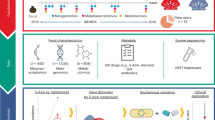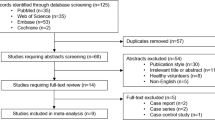Summary
Twenty-eight outpatients receiving sulfasalazine for inflammatory bowel disease were monitored. Assessment of acetylator phenotype according to the percentage of acetylated sulfapyridine in serum provided a clear distinction between rapid and slow acetylators. In comparison, the percentage of acetylated sulfapyridine in saliva or urine was a less precise index of phenotype. Determination of saliva concentrations of sulfapyridine and N4-acetylsulfapyridine did not provide a reliable estimate of serum levels. Slow acetylators had significantly higher serum concentrations of sulfapyridine (21.9±14.0 [SD] µg/ml) than rapid acetylators (8.8±4.3 µg/ml) and had a higher incidence of toxicity (not statistically significant,p>0.05). Serum concentrations of sulfapyridine were significantly higher in patients with symptoms of toxicity (23.2±15.9 µg/ml) than those without (13.9±9.5 µg/ml) (p<0.05). However, serum concentrations of total sulfapyridine (sulfapyridine plus N4-acetylsulfapyridine) were not significantly different in patients with (32.9±21.2 µg/ml) or without (22.8±12.0 µg/ml) toxicity (p>0.05). For all patients serum concentrations of sulfapyridine (total sulfapyridine) ranged from 3.5 to 73.1 (5.7 to 95.1) µg/ml in patients with controlled disease and 6.3 to 38.0 (14.0 to 54.7) µg/ml in patients with active disease. A significant correlation between clinical status of disease and serum drug concentrations was only apparent for rapid acetylators (p<0.05). The daily sulfasalazine dosage (mg/kg of body weight, log value) and serum drug concentrations (log values) were highly correlated (p<0.05). For clinical evaluation of inflammatory bowel disease patients determination of serum sulfapyridine concentrations appears to be more important for monitoring toxicity than therapeutic efficacy of sulfasalazine. Assessment of acetylator status appears to be useful for predicting serum sulfapyridine levels in patients receiving sulfasalazine therapy.
Similar content being viewed by others
References
Northfield TC (1979) Drug treatment of inflammatory bowel disease. Prescriber's J 19: 80–86
Poley JR (1978) Chronic inflammatory bowel disease in children and adolescents, Part I. South Med J 71: 935–948
Poley JR (1978) Chronic inflammatory bowel disease in children and adolescents. South Med J 71: 1123–1133
Khan AKA, Piris J, Truelove SC (1977) An experiment to determine the active therapeutic moiety of sulphasalazine. Lancet 2: 892–895
Serebro KS, Javett S, Abrahams C (1977) Sulphasalazine rectal enemas: Topical method of inducing remission of active ulcerative colitis affecting rectum and descending colon. Br Med J 4: 1264
van Hees PAM, Tuinte JHM, van Rossum JM van Tongeren JHM (1979) Influence of intestinal transit time on azo-reduction of salicylazosulphapyridine (salazopyrin). Gut 20: 300–304
Chapron DJ, Kramer PA, Mercik SA (1980) Kinetic discrimination of three sulfamethazine acetylation phenotypes. Clin Pharmacol Ther 27: 104–113
Das KM, Eastwood MA (1975) Acetylation polymorphism of sulfapyridine in patients with ulcerative colitis and Crohn's disease. Clin Pharmacol Ther 18: 514–520
Day JM, Houston JB (1980) Saliva: Plasma concentration relationships for sulphapyridine following sulphasalazine administration to normal volunteers and patients with inflammatory bowel disease. Br J Clin Pharmacol 9: 91–94
Fischer C, Klotz U (1979) High-performance liquid chromatographic determination of aminosalicylate, sulfapyridine and their metabolites. Its application to pharmacokinetic studies with salicylazosulfapyridine in man. J Chromatogr 162: 237–243
Das KM, Eastwood MA, McManus JPA, Sircus W (1973) The metabolism of salicylazosulfapyridine in ulcerative colitis. I. The relationship between metabolites and the response to treatment in inpatients. Gut 14: 631–636
Das KM, Eastwood MA, McManus JPA, Sircus W (1973) Adverse reactions during salicylazosulphayridine therapy and the relation with drug metabolism and acetylator phenotype. N Engl J Med 289: 491–495
Goodacre RL, Vanderlinden AB, Hamilton JP, Castelli M, Seaton T (1978) Hemolytic anemia in patients receiving sulfasalazine. Digestion 17: 503–508
Schroder H, Evans DAP (1972) Acetylator phenotype and adverse effects of sulphasalazine in healthy subjects. Gut 13: 278–284
Van Hees PAM, van Elferen LW, van Rossum JM, van Tongeren JH (1979) Hemolysis during salicylazosulfapyridine therapy. Am J Gastroenterol 70: 501–505
Das KM, Eastwood MA, McManus JPA, Sircus W (1973) The metabolism of salicylazosulfapyridine in ulcerative colitis. II. The relationship between metabolites and the progress of the disease studied in outpatients. Gut 14: 637–641
Sharp ME, Wallace SM, Hindmarsh KW, Brown MA (1980) HPLC and GLC analysis of sulfapyridine and acetylsulfapyridine: Development and selection of a suitable procedure for biological fluid analysis. Can J Pharm Sci 15: 35–38
Draper NP, Smith H (1976) Applied regression analysis. J Wiley and Sons, New York
Schroder H, Campbell DES (1972) Absorption, metabolism and excretion of salicylazosulfapyridine in man. Clin Pharmacol Ther 13: 539–551
Vree TB, O'Reilly WJ, Hekster VA, Damsma JE, van der Kleijn E (1980) Determination of the acetylator phenotype and pharmacokinetics of some sulphonamides in man. Clin Pharmacokinet 5: 274–294
duSouich P, McLean AJ, Stoeckel K, Ohlendorf D, Gibaldi M (1979) Screening methods using sulfamethazine for determining acetylator phenotype. Clin Pharmacol Ther 26: 757–765
Mucklow JC, Bending MR, Kahn GC, Dollery CT (1978) Drug concentration in saliva. Clin Pharmacol Ther 24: 563–570
Bates TR, Blumenthal HP, Peiniaszek HJ (1977) Salivary excretion and pharmacokinetics of sulfapyridine after sulfasalazine. Clin Pharmacol Ther 22: 917–927
Cowan GO, Das KM, Eastwood MA (1977) Further studies of sulphasalazine metabolism in the treatment of ulcerative colitis. Br Med J 2: 1057–1059
Goldstein PD, Alpers DH, Keating JP (1979) Sulfapyridine metabolites in children with inflammatory bowel disease receiving sulfasalazine. J Pediatr 95: 638–640
Singleton JW, Law DH, Kelly ML, Mekhjian HS, Sturdevant RAL (1979) National Cooperative Crohn's Disease Study: Adverse reactions to study drugs. Gastroenterology 77: 870–882
Author information
Authors and Affiliations
Rights and permissions
About this article
Cite this article
Sharp, M.E., Wallace, S.M., Hindmarsh, K.W. et al. Acetylator phenotype and serum levels of sulfapyridine in patients with inflammatory bowel disease. Eur J Clin Pharmacol 21, 243–250 (1981). https://doi.org/10.1007/BF00627927
Received:
Revised:
Accepted:
Issue Date:
DOI: https://doi.org/10.1007/BF00627927




